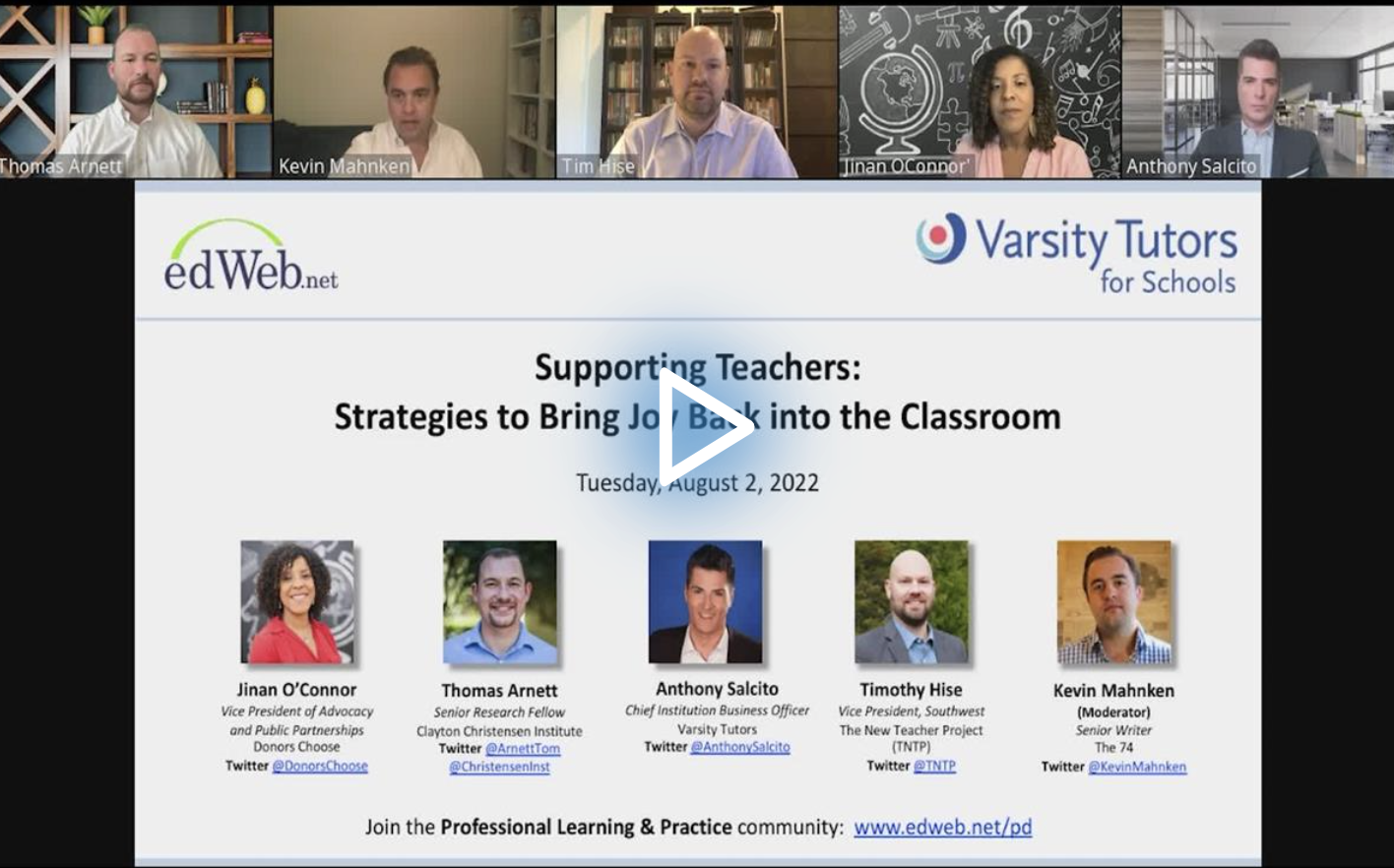Keeping Teachers Committed to Teaching: Make Them Happy
Watch the Recording Listen to the Podcast
Teachers and students suffered through COVID’s upheavals. With its dissipation come the aftereffects, from unfinished learning to teacher shortages. The pandemic furthered a lingering malaise linked to existing school gaps and challenges.
Teachers are struggling but are not defeated. As they navigate a changing educational landscape to balance their personal and professional well-being, they’ve begun to voice their needs for support and resources to keep them content and productive in the classroom.
Their message is clear: Schools have immediate and long-term priorities to move teachers forward from the pandemic and tackle historical barriers to their satisfaction and impact. In the edLeader Panel, “Supporting Teachers: Strategies to Bring Joy Back into the Classroom,” educational experts shared research, strategies, and programs to foster a happier, more engaged teaching core.
Teacher Morale: Current Trends
What’s getting teachers down? Unfortunately, there are myriad impediments to what teachers love—nurturing student achievement. COVID certainly tops the list, resulting in unfinished learning, teacher shortages and resignations, and the pandemic’s lingering overall toll.
The pandemic, some might say, was the breaking point. But many teachers were already contending with systemic issues common to the educational community, such as low salaries, poor working conditions, lack of autonomy, few opportunities for career advancement, and unsustainable workloads.
The impact? Teacher job satisfaction is at a low. Data show that fewer educational professionals envision spending their entire careers in the classroom. Now is the time for long-term solutions for better experiences for students and teachers.
Starting Points
Administrators, advised the panelists, should listen to teachers carefully to identify what they want, what’s missing, and what can serve them better to heighten teacher job satisfaction, morale, and retention.
Research has unveiled several outstanding issues with possible solutions that can be the impetus for administrators to dig deep to discover their teachers’ unique needs and wants.
Project Innovation
Teachers strive to engage their students in creative ways. They have fantastic project ideas, but not the resources to make them come alive. Data show, however, that such projects are likely to enhance teacher satisfaction and retention.
Donors Choose, which helps teachers secure funding for projects, highlighted research indicating that teachers often propose projects to enhance their classroom working environment (technology, supplies, furniture, classroom experiences, etc.).
If implemented, such projects generate the most significant turnover reduction: The thought is that the initiatives help teachers make their classrooms a more enjoyable place to be for students and themselves. They also increase innovative teacher autonomy—the opportunity to experiment—a factor in their decision to remain in the classroom.
Curricular Options
Teachers seek curricula that enable them to differentiate instruction for an inclusive approach to addressing students’ learning diversity. They often find that mandated commercial or district-created curricula don’t allow for differentiation.
Schools require high-quality, standards-aligned materials, grade-appropriate materials that are equitable. But teachers contend there is a disconnect between what administrators see and what teachers see as curricular needs in the classroom. Surveys show that teachers search for curricular workarounds in response, with 30% adopting online learning materials or creating them.
One solution is to provide required materials to comply with quality and equity requirements but to offer more than one set, diversifying the offerings that give teachers options to use the best for their students and instructional context.
Lightening the Teacher Load with Tutors
Classroom dynamics affect a teacher’s capacity to help students connect with content, particularly when differentiated or individualized learning is not an option. Unfinished learning, mainly due to COVID, exacerbates the pre-pandemic learning and achievement gaps already at play.
Tutoring often supplements learning outside of the classroom. In most instances, families with financial resources can afford the one-on-one academic support tutoring provides. A growing body of research suggests that while tutoring can be effective, the most impactful tutoring initiatives are deeply connected to the classroom, aligned to curriculum and standards, and provide consistent tutor relationships.
Consider as a model Varsity Tutors’ teacher-assigned tutors, which equips teachers with a team of tutors to deploy dynamically to help students during live, video-based, face-to-face, personalized tutoring.
The program is steeped in the classroom: Tutors work with teachers to focus on specific student challenges and achievement opportunities and address instructional and learning goals. They share materials and insights into student progress.
The Varsity model demonstrates how tutoring can supplement the work of overstretched—and often overworked and burned out—teachers who can’t always give students the individualized assistance that would benefit them.
Resources: Getting the Right Ones
Federal funding abounded during the pandemic. Schools purchased a range of products (much of them tech) useful in the short term. But many of these items ultimately joined the ranks of unused or non-functioning tools that have accumulated for years.
Teachers need products and resources that support their teaching and the instructional decisions they make in that context. Again, administrators should listen to teachers to identify their preferences and what drives them, understanding that multiple pathways lead teachers to change their practices or adopt new learning materials.
Schools must then figure out how to procure the items teachers want because they further foster what teachers aspire to do: make a difference in students’ lives through meaningful academic engagement.
Bringing Up Teacher Morale: Additional Tips
Given trends in the teacher workforce and related school and district policies, the panelists offered insight into other areas of concern administrators should be mindful of:
- The teacher pool needs to mirror student diversity. There should be strategically designed recruitment and retention practices for educators of color and equitable safety and inclusion practices.
- Districts and schools might consider strengthening the capacity of paraprofessionals, committed professionals, and often-talented educators to provide academic support in the classroom and to create pathways for their certification or alternative certification programs that remove cost barriers.
Learn more about this edWeb broadcast, “Supporting Teachers: Strategies to Bring Joy Back into the Classroom,” sponsored by Varsity Tutors for Schools.
Watch the Recording Listen to the Podcast
Join the Community
Professional Learning & Practice is a free professional learning community that presents edWebinars and hosts online discussion forums on a wide range of issues on professional learning and educator practice.
Varsity Tutors for Schools is your all-in-one live learning platform that delivers personalized learning to every student in your school district. Whatever challenges your students face, our proven solutions can be customized to meet their needs, providing equitable access to everything from on-demand to 1-on-1 high-impact tutoring to adaptive assessments.
Blog post by Michele Israel, based on this edLeader Panel






Comments are closed.